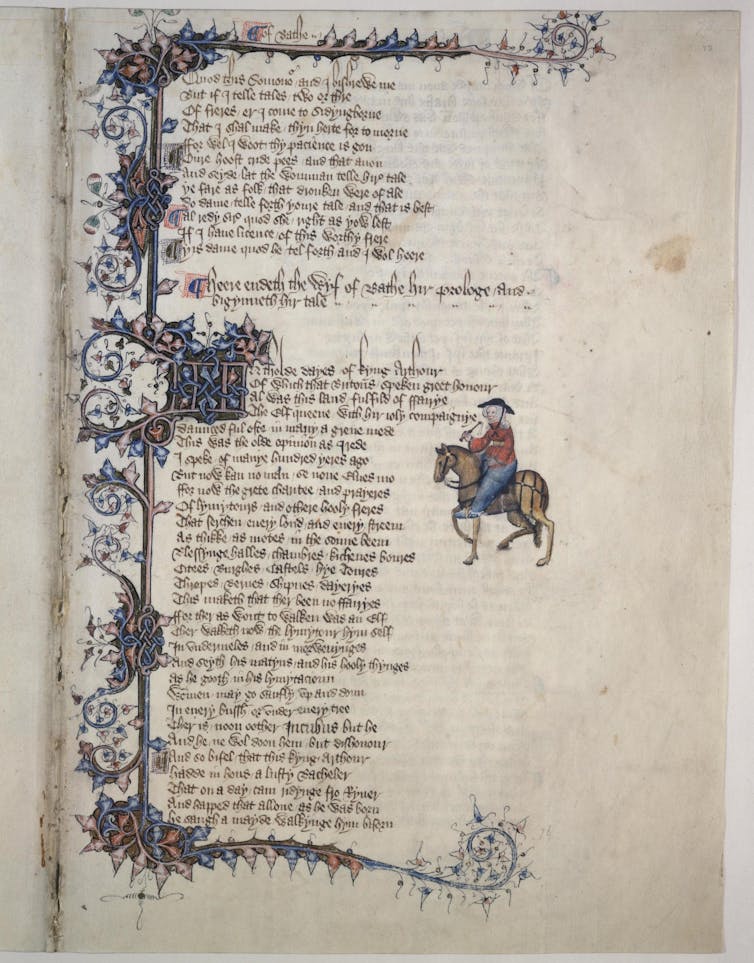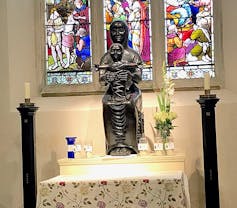
Dr Natalie Hanna is a Lecturer in the University of Liverpool’s Department of English
It could be easy to assume that The Canterbury Tales, a collection of stories written in Middle English at the end of the 14th century, would not hold much relevance to contemporary debates about sexuality and empowerment.
But as Zadie Smith shows in her new adaption and her first play, this definitely isn’t the case. The Wife of Willesden, is a high-spirited take on Chaucer’s “Wife of Bath”, one of the 24 stories in Geoffrey Chaucer’s The Canterbury Tales.
The Canterbury Tales tells the story of a group of 31 pilgrims who meet while travelling from the Tabard Inn in Southwark, South London, to the shrine of St Thomas Becket in Canterbury, Kent. Chaucer’s pilgrims – including Alysoun, the Wife of Bath – take turns telling stories on their travels.
Smith’s tale takes place during a pub lock-in – with locals celebrating the Borough of Brent winning the London Borough of Culture 2020. It was this win that led to Smith (Brent’s most famous writer) being commissioned to write a literary celebration of the borough. This is what prompted her to recreate Chaucer’s Wife of Bath in a modern form.
In the original text, audacious Alysoun gives the longest prologue of all of Chaucer’s pilgrims, describing how she has been married five times. She tells her tale about a knight of Camelot who rapes a maiden. As a result, the knight is sentenced by Queen Guinevere to find out what women want most.
For a year he has no luck, but he finally meets an old hag who gives him the answer and in return, he promises to repay her as she wishes – a rash promise he’ll soon regret. The answer turns out to be that women desire “sovereignty” over their husbands, and the knight’s promise means he ends up forced to marry the hag. Luckily for him, she also has the magical capacity to be a beautiful maiden, provided he grants her autonomy to choose which form she takes.
In The Wife of Willesden, Smith takes audiences from the medieval Southwark Tavern to the present-day Sir Colin Campbell pub on Kilburn High Street. And it is here we meet the red dress-clad, fake Jimmy-Choo sporting, cunnilingus-loving Alvita, played by Clare Perkins.
The tale told by Alvita, a 21st-century Wife of Bath, moves the location from the court of King Arthur to 18th-century Jamaica. Smith weaves medieval, contemporary and colonial contexts together with fiercely lewd humour that echoes Chaucer’s own bawdiness.
Shame and Choice
The lesson of Chaucer’s Wife of Bath about female sovereignty is particularly poignant because Chaucer was embroiled in a rape case of his own. Not much is known about the case other than the fact that Chaucer was released in 1380 from a charge of “raptus” made by Cecily Champaigne, the daughter of a London baker.
“Raptus” in court documents could indicate sexual assault, but also abduction for an arranged marriage. But whether or not the Wife’s Tale held personal significance to Chaucer, he chose to add the crime of rape to the tale and had Alysoun tell a story about sexual violence and choice. In fact, the rape does not appear in any of the source texts he worked with when writing his version.

Wikimedia Commons
In many ways, Chaucer’s Alysoun is a woman well ahead of her time. She condemns biblical scripture and medieval writings about women’s “chaste” conduct in marriage, arguing that God gave people reproductive organs to use, and she will use hers for profit and pleasure. Alysoun rejects literature that advises women to dress to protect their modesty. Instead, she wears scarlet stockings and new shoes – and goes on pilgrimage to be seen and to potentially woo a new lover.
Alvita is an unashamedly sex-positive woman in her mid-50s. She, like Alysoun, has been married five times. And, in Smith’s rough iambic couplets that render Willesden’s multicultural London dialects into verse, Alvita explains how she refuses to be told, by society, the church, her husbands, how to behave or dress:
My thing is: you want to think you’re a saint?
Fine. But don’t slut-shame me because I ain’t
Women’s Voices
In Chaucer’s time, Willesden was itself a place of pilgrimage, not least for what was thought to be a black Madonna shrine, known as Our Lady of Willesden.

Wikimedia Commons, CC BY
Smith plays on this by taking Chaucer’s “gat-tothed” (gap-toothed) Alysoun, imagining her as Alvita: “gap-toothed like (pop-star) Madonna”, a smile which Alvita tells us, “suits us both; symbolises passion”.
The comparison with the singer is one of the many instances where Alvita pleads that her many spouses should not treat her like the virgin she assuredly isn’t, but rather as an empowered, independent and experienced partner.
As with Chaucer’s Alysoun, Alvita rated three of her five husbands as good, because they were old and she was able to manipulate them, while two were bad: younger men who cheated, lied and abused her.
Smith’s adaptation uses Chaucer’s references to sexual desire, domestic violence and freedom of choice to explore contemporary concerns such as the sex-positive movement, #MeToo, and incels culture or “involuntary celibates”. Indeed, Alysoun’s arguments about clothing and sexuality become strikingly relatable to Alvita’s critiques of “slut-shaming” and victim-blaming.

Marc Brenner
Alvita is a thrilling (and perhaps troubling) reminder of the way that the concerns of Chaucer’s medieval characters are still relevant today. Though Smith’s more inclusive rendering gives a voice to those silent in the original text, like Alysoun’s “gossib” (close friend) who becomes Alvita’s outspoken “ride-and-die bitch”, Zaire.
Ultimately though, at a time when even famous women can struggle to tell their stories against powerful men, such tales about female agency have never been more crucial.![]()
This article is republished from The Conversation under a Creative Commons license. Read the original article.